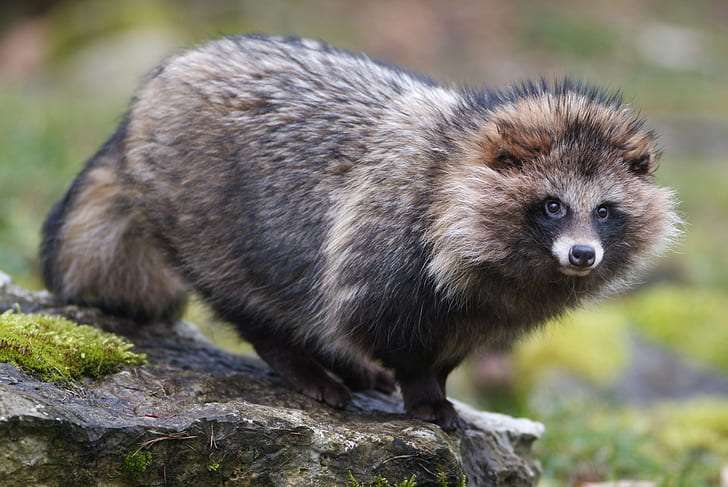SCORES & OUTDOORS: Raccoon dogs make headlines; what are they?
 by Roland D. Hallee
by Roland D. Hallee
Over the past weekend, I read a news release about materials collected at a Chinese market near where the first human cases of Covid-19 were identified showing raccoon dog DNA comingled with the virus, suggesting the pandemic may have originated from animals, not a lab. The World Health Organization director general Tedros Adhanom Ghebreyesus criticized China for not sharing the genetic information earlier. It appears samples collected from a stall known to be involved in the wildlife trade also contained raccoon dog genes, indicating the animals may have been infected by the virus.
In China, raccoon dogs are often bred for their fur and sold for meat in animal markets. So, that brings the question, what is a raccoon dog?
The common raccoon dog, also called the Chinese or Asian raccoon dog to distinguish it from the Japanese raccoon dog, is a small, heavy-set, fox-like canid native to East Asia. Named for its raccoon-like face markings, it is most closely related to foxes.
Common raccoon dogs feed on many animals and plant matter, and are unusual among canids (dogs and foxes) for climbing trees and for hibernating in cold winters. They are widespread in their native range, and are invasive in Europe where they were introduced for the fur trade. The similar Japanese raccoon dog, native to Japan, is the only other living member of the genus. Other names for the common raccoon dog include mangut (its Evenki name), and neoguri (its Korean name).
The common raccoon dog is named for the resemblance of its masked face to that of the North American common raccoon. The closest relatives of the common raccoon dogs are the true foxes, not the raccoon, and not closely related.
Due to the fur trade, the common raccoon dog has been widely introduced in Europe, where it has been treated as a potentially hazardous invasive species. In Europe, since 2019, the common raccoon dog has been included on the list of Invasive Alien Species of Union concern. This implies that this species cannot be imported, bred, transported, commercialized, or intentionally released into the environment in the whole of the European Union.
Common raccoon dogs are omnivores that feed on insects, rodents, amphibians, birds, fish, reptiles, mollusks, crabs, sea urchins, human garbage, carrion, eggs, and insectivores, as well as fruits, nuts, and berries. Among the rodents targeted by common raccoon dogs, voles seem to predominate in swampy areas, but are replaced with gerbils in flatland areas.
Common raccoon dogs eat beached fish and fish trapped in small water bodies. They rarely catch fish during the spawning season, but eat many during the spring thaw. In their southern range, they eat young tortoises and their eggs. Insectivorous mammals hunted by common raccoon dogs include shrews, hedgehogs, and, on rare occasions, moles and desmans. In the Ussuri territory, large moles are their primary source of food. Plant food is highly variable, and includes bulbs, rhizomes, oats, millets, maize, nuts, fruits, berries, grapes, melons, watermelons, pumpkins, and tomatoes.
Common raccoon dogs adapt their diets to the season; in late autumn and winter they feed mostly on rodents, carrion, and feces, while fruit, insects, and amphibians predominate in spring. In summer they eat fewer rodents, and mainly target nesting birds, fruits, grains, and vegetables.
After all this, it sounds like the common raccoon dog is a canine garbage disposal.
Wolves are the main predators of common raccoon dogs, killing large numbers of them in spring and summer, though attacks have been reported in autumn, too.
Both foxes and European badgers compete with common raccoon dogs for food, and have been known to kill them if common raccoon dogs enter their burrows. Common raccoon dogs are the only canids known to hibernate.
Like foxes, they do not bark, uttering instead a growl, followed by a long-drawn, melancholy whine.
The common raccoon dog is now abundant throughout Finland, Estonia, Latvia, and Lithuania, and has been reported as far away as Denmark, Norway, and Sweden, Belarus, Poland, Germany, Netherlands, Belgium, Luxembourg, France, Switzerland, Czech Republic, Hungary, Romania, Bulgaria, Serbia, and Moldova.
In June 2021, a study commissioned by the United Kingdom’s Department for Environment, Food and Rural Affairs identified the common raccoon dog as one of 20 invasive species likely to spread to the British Isles.
From what I have been able to find, it looks like the common raccoon dog is not a welcomed species. In its defense, evidence has also been gathered that indicates the raccoon dogs cages may have been stored in that same stall with those of bats, and that the bats are the source, and the raccoon dogs may have become an unsuspecting carrier of the virus.
Roland’s trivia question of the week:
Who was the last Boston Celtics player to be named the NBA Most Valuable Player?
Responsible journalism is hard work!
It is also expensive!
If you enjoy reading The Town Line and the good news we bring you each week, would you consider a donation to help us continue the work we’re doing?
The Town Line is a 501(c)(3) nonprofit private foundation, and all donations are tax deductible under the Internal Revenue Service code.
To help, please visit our online donation page or mail a check payable to The Town Line, PO Box 89, South China, ME 04358. Your contribution is appreciated!



Leave a Reply
Want to join the discussion?Feel free to contribute!